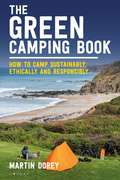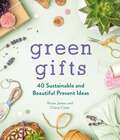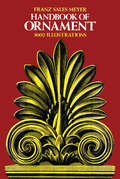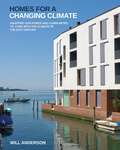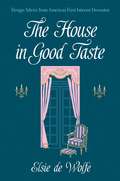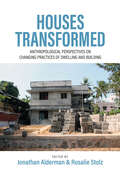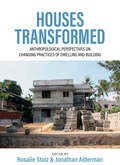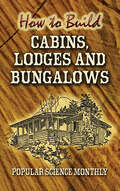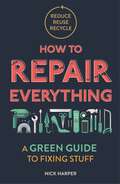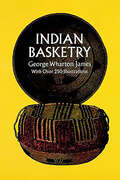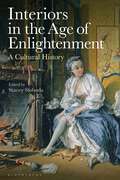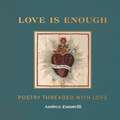- Table View
- List View
The Green Camping Book: How to camp sustainably, ethically and responsibly
by Mr Martin DoreyFrom Martin Dorey - lifelong camper, campervanner and committed environmentalist - a manifesto on how to camp greener and more responsibly while enjoying the outdoors.Planet earth is in crisis. Climate change is affecting everyone, and everyone has a responsibility to do all they can to make things better, including campers and campervanners. In fact, it often falls to us to protect our spaces and fight to keep them the way we like them.This book shows us how we can do it. The Green Camping Book signposts you towards making more sustainable choices about kit, where to stay, how to travel, what to wear, and what we can keep doing to fight for green spaces we love. It is a book for people who want to reduce their impact and carbon footprint but don't want to stop exploring. It is for people who want to get out, off the sofa, and into the wilderness without doing it further damage. It is for people who think they could do more, but don't know how. It asks of everyone who likes spending time outdoors to think about their impact and to take urgent, important steps to soften their footprint on the world.
Green Gifts: 40 Sustainable and Beautiful Present Ideas
by Rosie James Claire CaterFrom homemade spa-day pamper products to gorgeous homewares, these 40 eco-gifting ideas will show you how to create presents from everyday household items. Whether you're eco-conscious and keen to reduce your plastic usage or want to be more sensible with your spending, this gorgeous craft compendium provides step-by-step guides to produce gifts that don't compromise on design or quality. Presents for sustainable living Home-grown plants and succulents from cuttings Self-care treatsOn-the-go necessities Special occasions Presents for furry loved ones … as well as tips and tricks on creating your own wrapping paper and gift tags, and much more besides. You'll be able to create modest yet striking products from items in your home and reward friends and family with carefully made contemporary treats. And by replacing disposable presents with recycled, eco-friendly ones that have been hand-made from materials in your home, you'll be saving your pennies while saving the world. The ultimate guide to eco-living and giving.
Handbook of Ornament: A Grammar Of Art, Industrial And Architectural Designing In All Its Branches, For Practical As Well As Theoretical Use (classic Reprint) (Dover Pictorial Archive Ser.)
by Franz Sales MeyerRepublished unabridged from the final comprehensive edition, this work contains the largest single-volume collection of classical art motifs ever compiled. It reproduces material from Greek and Roman, medieval European, Islamic, Renaissance, baroque, and early nineteenth-century art, architecture, and design — in all, presenting artists, crafters, and students with more than 3,000 designs.Featured design elements include networks, Gothic tracery, geometric designs, akanthos leaves, lotus ornamentation, animal ornamentation, grotesque figures, fret bands, chains, interlacements, rosettes, undulations, spirals, link borders, cresting borders, finials, crockets, gargoyles, foliations, panels, repeated ornaments, and hundreds of other elements. Other plates show decorated pottery vases, religious utensils, weapons, furniture, lamps, jewelry, and other artifacts, in addition to heraldic motifs and ornamental letters.
Homes for a Changing Climate: Adapting Our Homes and Communities to Cope with the Climate of the 21st Century
by Will AndersonAn exploration into the history of our collective response to the challenges of extreme weather conditions and climate.At the beginning of the twenty-first century, the world finally woke up to the reality of climate change and began the arduous task of freeing itself from dependence on fossil fuels. But the time lag in the Earth's ecosystem is such that our best efforts to cut carbon today will make little difference to the changing climate of the next 30 years. As we work towards a secure, low-carbon future, we must address the changes that are already taking place in the planet's climate. We must learn to live with higher temperatures, intense rainstorms, rising sea levels and prolonged drought. We must also confront the secondary impacts of climate change, especially on energy and food security.Britain has a mild, temperate climate where occasional weather extremes tend to have serious impacts because we are simply not prepared for them. Yet across the world, communities have been living with such extremes for millennia. If we have the imagination to learn from others and rethink the ways we build and live together, we can face this unsettling future with confidence.Homes for a Changing Climate celebrates this collective wisdom, exploring traditional and contemporary responses to the challenges of climate and illustrating the many ways in which houses can be designed, built and adapted to cope with these challenges. Examples are drawn from across Europe including the supervolcano of Thera, the 100mph winds of the Western Isles, and the cutting-edge eco-building projects in Britain. Based on the climate projections for the UK published by the Met Office in June 2009, Homes for a Changing Climate combines inspiring case studies, striking photography and practical advice to create a book of imagination and hope in uncertain times.
The House in Good Taste: Design Advice from America's First Interior Decorator (Dover Architecture)
by Elsie De Wolfe"Good taste can be developed in anyone, just as surely as good manners are possible to anyone. And good taste is as necessary as good manners," declared Elsie de Wolfe, the "first lady" of American interior design. Although de Wolfe decorated the homes of wealthy, socially prominent clients, she always maintained that her vision of elegant but comfortable living is attainable to all. This timeless 1913 book, written in a friendly, conversational tone, explains how to design, furnish, and decorate a house in order to make it a beautiful, useful, and livable home.De Wolfe pioneered the concept of the home as a representation of the owner's identity, and this book defines her decorating methods, philosophy, and approach to creating spaces for gracious entertaining. Part step-by-step manual and part aesthetic treatise, this volume advocates for simpler yet more refined decor. In contrast to the Victorian penchant for dark furniture, bric-a-brac, and heavy draperies, de Wolfe advised her readers to let in natural light, to replace gaudy colors with beige and ivory, and to abandon clutter. Her practical suggestions, illustrated by period photographs, illuminate the attitudes of a century ago while retaining their resonance for modern-day interior designers.
Houses Transformed: Anthropological Perspectives on Changing Practices of Dwelling and Building
by Rosalie Stolz Jonathan AldermanOver the decades, there has been a world-wide transformation of so-called ‘vernacular houses’. Based on ethnographic accounts from different regions, Houses Transformed investigates the changing practices of building houses in a transnational context. It explores the intersection of house biographies and social change, the politics of housing design, the social fabrication of aspirational houses, the domestication of concrete and the intersection of materiality and ontology as well as the rhetoric of the vernacular. The volume provides new anthropological pathways to understanding the dynamics of dwelling in the 21st century.
Houses Transformed: Anthropological Perspectives on Changing Practices of Dwelling and Building
Over the decades, there has been a world-wide transformation of so-called ‘vernacular houses’. Based on ethnographic accounts from different regions, Houses Transformed investigates the changing practices of building houses in a transnational context. It explores the intersection of house biographies and social change, the politics of housing design, the social fabrication of aspirational houses, the domestication of concrete and the intersection of materiality and ontology as well as the rhetoric of the vernacular. The volume provides new anthropological pathways to understanding the dynamics of dwelling in the 21st century.
How to Build Cabins, Lodges and Bungalows
by Popular Science Monthly"Nothing could be more American than the simple cabin. Not many generations ago, it was the backbone of American life, the headquarters of that important unit, the home. It provided shelter, protection, and a foundation upon which to build a great empire. The pioneer cabin was, in other words, a necessity." -- From the IntroductionOnce regarded as a safe haven and a vital source of security, the little cabin in the country is today more closely associated with leisurely activities -- a vacation spot and even a health investment. First published in the 1930s, this helpful guide was designed to provide vacation home builders with all the information they needed to construct, decorate, and furnish a rustic little cottage. Floor plans and outlines of necessary materials are included, as are tips on constructing foundations, porches, doors, windows, fireplaces, and other structural elements. There are even suggestions for furnishing and beautifying your cabin.A useful how-to manual, offering straightforward advice on the building process from foundation to roof, this practical book can also be enjoyed as an entertaining look at lifestyle elements of the early twentieth century.
How to Repair Everything: A Green Guide to Fixing Stuff
by Nick HarperWith advice on tools, materials and methods and written in an easy-to-follow, step-by-step format, this is a book that makes it easier to say ‘NO’ to our disposable society and make a real difference.___________‘Covers a vast range of jobs and gives simple, clear instructions’ – Sunday Post‘Reminds us that there’s a solution for every problem’ – Glamour___________Not everything has built-in obsolescence – as this fantastically handy guide to fixing everyday objects proves! Whether you need to repair the strap of a favourite handbag or mend a leak in a washing machine, How to Repair Everything is packed full of tips and tricks of the trade for the person who likes to do-it-yourself. From quick fixes that will get you out of a jam to permanent solutions that make the item good as new, this is perfect for anyone who hates the throwaway society and would much rather refurb and recycle.Whether it’s a sweater that’s shrunk in the wash, a broken umbrella spoke or fixing a microwave oven, you’ll be amazed just how many things can be mended with a few tools and a bit of patience.
Igloo (Large Print)
This image shows an igloo from the front. There is a locator dot shown, which will be at the top left of the page when the image is the right way up. The igloo is a dome-shaped structure and fills the page. It is constructed of rectangular blocks of ice fitted together in offset layers like house bricks. The arched entrance is at the end of a short rounded tunnel, and is shown at the lower centre of the image.
Igloo (UEB Contracted)
This image shows an igloo from the front. There is a locator dot shown, which will be at the top left of the page when the image is the right way up. The igloo is a dome-shaped structure and fills the page. It is constructed of rectangular blocks of ice fitted together in offset layers like house bricks. The arched entrance is at the end of a short rounded tunnel, and is shown at the lower centre of the image.
Igloo (UEB uncontracted)
This image shows an igloo from the front. There is a locator dot shown, which will be at the top left of the page when the image is the right way up. The igloo is a dome-shaped structure and fills the page. It is constructed of rectangular blocks of ice fitted together in offset layers like house bricks. The arched entrance is at the end of a short rounded tunnel, and is shown at the lower centre of the image.
Indian Basketry
by George W. JamesSince it first publication in 1901, this pioneering study by George Wharton James, once a leading collector and authority, has become a valuable source book for American Indian basketry. From Poma mush baskets to Paiute dicing trays, Indian Basketry traces the origin, development, and fundamental principles of Indian basket designs for the major tribal units in Southwestern United States and Pacific Coast, with occasional comments on the basket weaving of a number of other North American tribes.Author of several books on the Southwest, George James has used his extensive experience in the field to compile indispensable information (much gathered directly through interviews with Indian basketmakers) covering nearly every aspect of Indian basketry: esthetics, designs, dyes, and coloration, weaving and stitching techniques (including the bamtush and dah-lah methods), basket types, tribal variation, and functional considerations, offering clear instructions for those who may be interested in reproducing these ancient American crafts. James also includes a description of various native weaving materials such as pine root, bark, sumac, willow, twigs, fern stalks, grass and palm fronds, with suggestions regarding the ways in which the Indians wove shells, feathers, beads, leather, and pine needles into their basket designs.The book is a valuable aid for the artist, designer, and craftsman, or even for the beginner, who may wish to re-create authentic and often extinct basket forms and decorative motifs. It is also most useful to the collector, cultural historians, ethnologist, scholar, or buff, who desires to know more about specific aspects of Indian basketry, or about Indian arts in general. As an important contribution to the historiography of American Indian culture, this may be one of the most practical Indian basketry books that you could own.
Interiors in the Age of Enlightenment: A Cultural History
Interiors in the Age of Enlightenment provides a comprehensive and interdisciplinary overview of the cultural history of interior design and interior spaces from 1700 to 1850.Considering the interior as material, social and cultural artefact, this volume moves beyond conventional descriptive accounts of changing styles and interior design fashions, to explore in depth the effect on the interior of the materials, processes, aesthetic philosophies and cultural attitudes of the age.From the Palace of Versailles to Virginia coffeehouses, and from Chinoiserie bathhouses to the trading exchanges of the West Indies, the chapters in this book examine a wide range of themes including technological advancements, public spaces, gender and sexuality, and global movements in interior designs and decorations. Drawing together contributions from leading scholars, this volume provides the most authoritative and comprehensive survey of the history of interiors and interior architecture in the long eighteenth century.
Landscape Appreciation: Theories since the Cultural Turn
by David JacquesExplanations for what makes one landscape scene preferred over another - formalistic, cultural and ecological - continue to be generated by landscape architects and land managers, philosophers and psychologists.This is needed for planning in the countryside and the protection of natural scenery, yet agreement still eludes us. This book does not favour any particular theory, but critiques the many theories seen over the last half-century. It informs readers of the main lines of argument so that they can make up their own minds. Part one, on post-war aesthetics, examines ideas about the unconscious, holism, overarching 'metanarratives', and the search for objectivity. Part two describes the consequences on the 'cultural turn' in that period, giving rise to new theories taking the human as reference. Cultural geography, cultural landscapes, changes in methods of assessment and some new ideas on landscape design are set in this context. Ecocentrism proposed a very different approach. The final part looks into the philosophical input, expanding upon 'environmental aesthetics'. It concludes with a more down-to-earth analysis of 'satisfactions' from immediate formal qualities, the sublime, meanings, and beauty. The balanced, didactic approach taken will make this a standard text for all those in teaching and in landscape practice.
Lit match and box of matches (Large Print)
This image shows a match that has been lit and a box with matches in it. There is a locator dot shown, which will be at the top left of the page when the image is the correct way up. The lit match is at the top of the page. The box with matches is at the bottom of the page. The match heads are on the right in the box. Only the top of the matches can be found. Test your tactile skills: - Can you find the flame of the lit match - How many matches are there in the box?
Lit match and box of matches (UEB Contracted)
This image shows a match that has been lit and a box with matches in it. There is a locator dot shown, which will be at the top left of the page when the image is the correct way up. The lit match is at the top of the page. The box with matches is at the bottom of the page. The match heads are on the right in the box. Only the top of the matches can be found. Test your tactile skills: - Can you find the flame of the lit match - How many matches are there in the box?
Lit match and box of matches (UEB Uncontracted)
This image shows a match that has been lit and a box with matches in it. There is a locator dot shown, which will be at the top left of the page when the image is the correct way up. The lit match is at the top of the page. The box with matches is at the bottom of the page. The match heads are on the right in the box. Only the top of the matches can be found. Test your tactile skills: - Can you find the flame of the lit match - How many matches are there in the box?
Log Cabin (Large Print)
This image shows a gable wall view of a cabin constructed from logs. There is a locator dot shown which will be at the top left of the page when the image is the right way up. The pointed roof fills the top half of the page. The rounded ends of the supporting logs are shown down from the two sloping surfaces of the roof. On the right side of the image there is a crooked chimney sticking out from the roof. Down from the roof is the wall of the cabin. Here the rounded ends of the logs making up the side walls are shown at the left and right edges of the image, and these interleave with the slightly irregular length logs making up the wall shown. In the centre of this wall is a wooden door with a large door knob and ledges above and below it. At each side of the door there is a window with wooden ledges to top and bottom.
Log Cabin (UEB Contracted)
This image shows a gable wall view of a cabin constructed from logs. There is a locator dot shown which will be at the top left of the page when the image is the right way up. The pointed roof fills the top half of the page. The rounded ends of the supporting logs are shown down from the two sloping surfaces of the roof. On the right side of the image there is a crooked chimney sticking out from the roof. Down from the roof is the wall of the cabin. Here the rounded ends of the logs making up the side walls are shown at the left and right edges of the image, and these interleave with the slightly irregular length logs making up the wall shown. In the centre of this wall is a wooden door with a large door knob and ledges above and below it. At each side of the door there is a window with wooden ledges to top and bottom.
Log Cabin (UEB uncontracted)
This image shows a gable wall view of a cabin constructed from logs. There is a locator dot shown which will be at the top left of the page when the image is the right way up. The pointed roof fills the top half of the page. The rounded ends of the supporting logs are shown down from the two sloping surfaces of the roof. On the right side of the image there is a crooked chimney sticking out from the roof. Down from the roof is the wall of the cabin. Here the rounded ends of the logs making up the side walls are shown at the left and right edges of the image, and these interleave with the slightly irregular length logs making up the wall shown. In the centre of this wall is a wooden door with a large door knob and ledges above and below it. At each side of the door there is a window with wooden ledges to top and bottom.
Love is Enough: Poetry Threaded with Love (with a Foreword by Florence Welch)
by Andrea ZanatelliIn this truly beautiful book, Andrea Zanatelli combines his extraordinary artworks with a selection of classical love poetry by Anne Brontë, William Blake, Christina Rossetti, Emily Dickinson, Percy Shelley and many more.Drawing its inspiration from the past, Love is Enough references the decorative arts of a bygone era, and is a combination of romantic imagery, antique fabrics and allegorical illustrations, mixed with poems and mottos. Often mistaken for real embroidery pieces, the artworks are in fact very detailed and intricate digital collages, made to look and feel like handcrafted works.Zanatelli is strongly influenced by the Arts and Crafts movement and the Pre-Raphaelites as well as eighteenth-century collage artist and creator of the Flora Delanica, Mary Delany, among others. Recurring themes in his work are romantic love, magical symbols, Victorian era craftsmanship, historical nun’s work and relics. Details of paintings, ancient fabrics, antique jewellery and miniatures are also returning elements as they often become an integral part of the inspiration for the collages themselves.This stunning book is full of intricate detail and brimming with romance, so you can return to its pages again and again.
Male Lion (Large Print)
Here is a picture of a lion with his body shown from the side. There is a locator dot shown, which will be at the top left of the page when the image is the right way up. His head is at the left centre facing you, with two ears, two eyes, nose and mouth. The lion has a mane of thick long hair around his head. Lower down the page are the lion's two front legs, and to the right its back legs, all with long claws on the feet. At the right of the lion's body is its tail with a furry end.
Male Lion (UEB Contracted)
Here is a picture of a lion with his body shown from the side. There is a locator dot shown, which will be at the top left of the page when the image is the right way up. His head is at the left centre facing you, with two ears, two eyes, nose and mouth. The lion has a mane of thick long hair around his head. Lower down the page are the lion's two front legs, and to the right its back legs, all with long claws on the feet. At the right of the lion's body is its tail with a furry end.
